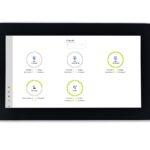Liteplan Emergency lighting specialists
Products
- Got a question?
- Ask a product specialist...
- +44 (0) 1708 372 223
LiteMesh-Local – Wireless Emergency Monitoring System
Ordering Codes
| Order Code | Description | ||
|---|---|---|---|
| Wireless Node | |||
| IQD/1/LOCAL | LiteMesh® 868Mhz DALI bridge node. One required for each DALI emergency control gear set | ||
| Gateway | |||
| LITEWAY/LOCAL | LiteMesh ready 868Mhz IoT gateway, connecting LiteMesh to the User Interface | ||
| User Interface | |||
| LMLOCAL/UI | LiteMesh Local User Interface Touchscreen and Wall Fixing | ||
| Commissioning Tool | |||
| LITEWORK/TABLET | Rugged touchscreen commissioning device operating IQRF and Wi-Fi Protocols for a simple commissioning process |
LiteMesh-Local – Wireless Emergency Monitoring System
Specifications
- Simple to Navigate Touchscreen User Interface
- Compatible with any Manufacturer’s DALI Control Gear
- Fault Locations show in Floorplan Format
- Simple Installation and Commissioning Process
- Robust and Secure Mesh Technology
The LiteMesh network uses the IQRF protocol. This features mesh hopping capability. A secure, scalable and resilient mesh network. The network becomes stronger, the more it grows.
Technical Mesh Data:
IQMESH® routing protocol utilising optimised directional flooding brings outstanding network robustness
IQRF® DPA commands (a standardising language) assure simple integration and interoperability
Multilayer security based on industry standard 128-AES is extended by dynamic keys generation and exchange which makes wireless communication significantly more immune to cyber-attacks.
FRC® (Fast Response Commands) dramatically increases network throughput and reliability.
SW: OS + DPA + Appl. + SDK
Band: 433 / 868 / 916 MHz
Network topology: Mesh
Range (device to device): 500+ meters line of sight, up to 100 meters within a building.
Range (device to gateway): Tens of kilometres
Native multi-hop: 240 hops per packet
Routing algorithm: Optimised directional flooding
Security: Multilayer, AES-128, dynamic keys
Directionality: Bi-directional
End Devices OTA Management: for all operations needed
Main benefit: easy adoption / reliability
LOW POWER
With 240 hops and robust routing, IQRF® is the best fit for large control applications, such as street lighting, emergency lighting or parking, where reliability and security is a must.
Each mesh hops data to the gateway which then reports to the user interface touchscreen, which displays information in a simple graphical format. The gateways are persistent without communication. Therefore, if for any reason communication is lost, data is held at the gateway until the signal is re-established.
The LiteWay gateway does not connect to the internet. Communication is sent from each fitting, through the mesh, to the user interface via the gateway, without the need to connect to the outside world. This reduces cost due to the mitigation of data management and storage.












